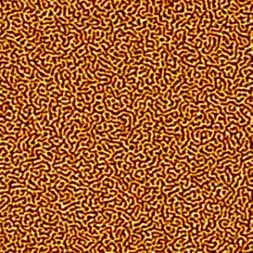Origin of ultra-fast manipulation of domain walls discovered

Magnetic force microscopy image of a 10µm X 10µm sized sample showing a labyrinth-type magnetic domain structure. The magnetization is oriented perpendicularly to the surface (white: magnetization pointing out of the plane; brown: magnetization pointing into the plane).<br><br>photo/©: Bastian Pfau, TU Berlin<br>
An international team of researchers has found at the free electron laser FLASH a surprising effect that leads in ferromagnetic materials to a spatially varying magnetization manipulation on an ultrafast timescale.
This effect could be the key to further miniaturization and performance increase of magnetic data storage devices. From Mainz, the group of Professor Dr. Mathias Kläui from the Institute of Physics at Johannes Gutenberg University Mainz and in particular Felix Büttner, a member of the Graduate School of Excellence “Materials Science in Mainz”, were involved. The results have been published in the current issue of Nature Communications.
It is known that magnetization can be manipulated by short light pulses but so far the spatially-resolved magnetization change could not be determined due to the limited spatial resolution of conventional optical techniques. Since most of the ferromagnetic materials consist of multiple domains with different magnetization directions, the local change of the magnetization in these domains and at the interfaces between the domains, i.e. at the so-called domain walls, is of particular interest.
At the FLASH free electron laser at the DESY Research Center in Hamburg, results were obtained that are in agreement with a recently theoretically predicted mechanism: due to the laser pulses, highly excited electrons are generated that move quickly through the material. They thus move from one domain into a neighboring domain with a different magnetization direction. Since the electrons carry part of the magnetization, they manipulate the magnetization in the domains as they move across a domain wall. This means that domain walls can change their geometry on the fs time scale.
As domain walls are also used in memory devices, such as the racetrack memory, these investigations could be the first step to improving the performance of such devices. The racetrack memory is a development by IBM and could in the future be a fast and low power alternative to conventional random access memory or hard drives.
The experiments were carried out by the researchers from Johannes Gutenberg University Mainz (JGU) with colleagues from TU Berlin, the universities of Hamburg and Paris, and six further research institutes at the free electron laser FLASH at DESY in Hamburg. The samples investigated consist of a cobalt-platinum multilayer system, which forms labyrinth-type domain structures.
Publication
B. Pfau et al., Ultrafast optical demagnetization manipulates nanoscale spin structure in domain walls, Nature Communications, 3:1100, 2 October 2012,
doi:10.1038/ncomms2108
Contact
Professor Dr. Mathias Kläui
Institute of Physics
Johannes Gutenberg University
D 55099 Mainz
phone +49 6131 39-23633
fax +49 6131 39-24076
e-mail: klaeui@ni-mainz.de
Media Contact
All latest news from the category: Materials Sciences
Materials management deals with the research, development, manufacturing and processing of raw and industrial materials. Key aspects here are biological and medical issues, which play an increasingly important role in this field.
innovations-report offers in-depth articles related to the development and application of materials and the structure and properties of new materials.
Newest articles

Security vulnerability in browser interface
… allows computer access via graphics card. Researchers at Graz University of Technology were successful with three different side-channel attacks on graphics cards via the WebGPU browser interface. The attacks…

A closer look at mechanochemistry
Ferdi Schüth and his team at the Max Planck Institut für Kohlenforschung in Mülheim/Germany have been studying the phenomena of mechanochemistry for several years. But what actually happens at the…

Severe Vulnerabilities Discovered in Software to Protect Internet Routing
A research team from the National Research Center for Applied Cybersecurity ATHENE led by Prof. Dr. Haya Schulmann has uncovered 18 vulnerabilities in crucial software components of Resource Public Key…





















